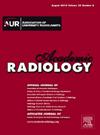The Value of Multi-directional High b-Value DWI in the Assessment of Muscular Invasion in Bladder Urothelial Carcinoma: In Comparison with VI-RADS
IF 3.8
2区 医学
Q1 RADIOLOGY, NUCLEAR MEDICINE & MEDICAL IMAGING
引用次数: 0
Abstract
Rationale and Objectives
To predict the muscular invasion status of bladder urothelial carcinoma (UCB) using quantitative parameters from multi-directional high b-value diffusion-weighted imaging (MDHB-DWI), and compare these parameters with the Vesical Imaging Reporting and Data System (VI-RADS).
Methods
In this prospective study, patients with pathologically confirmed UCB were enrolled between May 2023 and May 2024. All participants underwent preoperative MRI, including MDHB-DWI and conventional MRI. The average quantitative parameter values of MDHB-DWI (diffusion kurtosis imaging [DKI], diffusion tensor imaging [DTI], mean apparent propagator [MAP] and neurite orientation dispersion and density imaging [NODDI]) and apparent diffusion coefficient (ADC) values were compared between non-muscle invasive (NMIBC) and muscle-invasive (MIBC) groups using the T-test or rank sum test. Quantitative MRI models were developed using multivariate logistic regression analyses based on significant diffusion parameters obtained from MDHB-DWI. Receiver operating characteristic (ROC) curves were plotted, and DeLong's test was applied to compare the area under the curve (AUC) of the model with that of VI-RADS.
Results
A total of 76 patients with UCB (56 males; NMIBC/MIBC = 51/25) were included. Axial diffusivity (AD) from DKI and mean diffusivity (MD) from DTI were identified as independent predictors for constructing a quantitative MRI model. The AUC of the model was 0.936, significantly outperforming VI-RADS (AUC = 0.831) (p = 0.007).
Conclusion
DKI-AD and DTI-MD from MDHB-DWI demonstrate a robust ability to differentiate muscular invasion in UCB. Their combination significantly improves diagnostic efficiency compared to VI-RADS.
多方向高 b 值 DWI 在评估膀胱尿路上皮癌肌肉侵犯中的价值:与 VI-RADS 的比较。
依据和目的:利用多向高b值弥散加权成像(MDHB-DWI)的定量参数预测膀胱尿路上皮癌(UCB)的肌肉侵犯状态,并将这些参数与膀胱成像报告和数据系统(VI-RADS)进行比较:在这项前瞻性研究中,2023 年 5 月至 2024 年 5 月期间,病理确诊的 UCB 患者被纳入研究。所有参与者都接受了术前磁共振成像检查,包括MDHB-DWI和常规磁共振成像。采用T检验或秩和检验比较非肌肉浸润组(NMIBC)和肌肉浸润组(MIBC)的MDHB-DWI(扩散峰度成像[DKI]、扩散张量成像[DTI]、平均表观传播者[MAP]和神经元取向弥散和密度成像[NODDI])平均定量参数值和表观扩散系数(ADC)值。根据从 MDHB-DWI 中获得的重要弥散参数,使用多变量逻辑回归分析建立了 MRI 定量模型。绘制了接收者操作特征(ROC)曲线,并应用DeLong检验比较了模型与VI-RADS的曲线下面积(AUC):共纳入 76 名 UCB 患者(56 名男性;NMIBC/MIBC=51/25)。DKI的轴向弥散率(AD)和DTI的平均弥散率(MD)被确定为构建MRI定量模型的独立预测因子。该模型的AUC为0.936,明显优于VI-RADS(AUC=0.831)(P=0.007):结论:DKI-AD 和来自 MDHB-DWI 的 DTI-MD 在区分 UCB 肌肉侵犯方面表现出强大的能力。结论:与 VI-RADS 相比,DKI-AD 和来自 MDHB-DWI 的 DTI-MD 具有很强的区分 UCB 肌肉侵犯的能力,它们的组合能明显提高诊断效率。
本文章由计算机程序翻译,如有差异,请以英文原文为准。
求助全文
约1分钟内获得全文
求助全文
来源期刊

Academic Radiology
医学-核医学
CiteScore
7.60
自引率
10.40%
发文量
432
审稿时长
18 days
期刊介绍:
Academic Radiology publishes original reports of clinical and laboratory investigations in diagnostic imaging, the diagnostic use of radioactive isotopes, computed tomography, positron emission tomography, magnetic resonance imaging, ultrasound, digital subtraction angiography, image-guided interventions and related techniques. It also includes brief technical reports describing original observations, techniques, and instrumental developments; state-of-the-art reports on clinical issues, new technology and other topics of current medical importance; meta-analyses; scientific studies and opinions on radiologic education; and letters to the Editor.
 求助内容:
求助内容: 应助结果提醒方式:
应助结果提醒方式:


